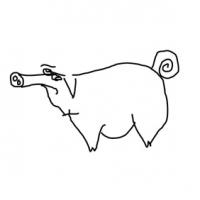Hi guys,
My name is Allan, i am 23 years old and i live in Sao Paulo, Brazil.
I majored in computer sciencie last year and now i am interested in learn 3D modeling to work as a graphic modeller games.
I've always loved games and believe that working with something you like is wonderful.
But I do not know how to begin my studies and what I should study.
Could someone help me?
Thanks!!
How to learn 3D modeling?
Blender is free and there is a ton of tutorials on their site.
Personally I prefer the very cheap MilkShape for low poly models but it doesn't do everything Blender can. Blender just has too steep a learning curve for me.
I'd certainly recommend playing with some free packages and using online tutorials before investing in any of the big players - Maya, 3DSMax etc. They are all quite expensive.
Personally I prefer the very cheap MilkShape for low poly models but it doesn't do everything Blender can. Blender just has too steep a learning curve for me.
I'd certainly recommend playing with some free packages and using online tutorials before investing in any of the big players - Maya, 3DSMax etc. They are all quite expensive.
It doesnt matter how fancy your render is (even if its indirect illumination!) if your models all suck.
Well in the world of modelling theres a few techniques you could try to master.
a) POLY MODELLING
this is when you usually start from a box or a plane then build planes or extrusions out of it creating more points and triangles... this is the most common method of modelling. It can get challenging as the models detail increases, slowly getting fiddlier and harder to modify as it gets more complicated. Is the most common form of modelling for something like a car or truck or building, because the large flat sides can be simulated with a few polys and points and it stays EXACT where you put it.
b) BOOLEAN SET OPERATIONS
this is taking a mesh of a cube, a mesh of a sphere, then chopping the cube out of the sphere or vice versa to make a hybrid shape. You can use any 2 operators you would like, and it can be easier than using a bevel and knife for carving the geometry how youd like. Me personally, I prefer to use both at the same time, boolean set operations can happen in poly modelling and also in voxels, which ill talk about later.
c) HIPOLY SUBDIVISION MODELLING
Say you have a finished poly modelled object, you can now use subdivision, which means dividing all the polys into half and doubling the count and itll also smooth over the surface by averaging all the divided points, making a gooey like surface out of a low poly one. What you have to do here is define edge loops by creating strips of polys around areas that you want to keep harsh angles on so they dont average out.
This is also the precursor to hipoly sculpting if you poly model it first.
This is mostly where mechanical modelling ends, as sculpting is too messy most of the time for clean mechanical shapes, unless you are really careful and know what your doing.
d) HIPOLY SCULPTING
I mean the infamous zbrush and its relatives where you start off by making a tube like structure (for arms and legs and other limbs and basic extrusions) or a poly modelled object is imported then its subdivided 1000 times and then you pass the mouse over the surface, and all the tiny micropolys will pull out where the mouse goes, and you form the object slowly out of clay. Can make a breeze out of modelling things that are kinda smooth or lumpy, like a face or character, but can be complete HELL for modelling something mechanical like a car or truck or building, where all the verts can not be put in the exact places that models like these require.
e) VOXEL SCULPTING
this uses a hybrid poly/voxel marching cubes algorythm which will let you sculpt about the same as normal sculpting except itll introduce detail as you make lumps instead of stretching points away from each other. Same problem with this form of sculpting is its really fiddly making anything mechanical with it, but on the other hand, you do get good boolean set operations. Is SLOWER than traditional sculpting, so you need a really good computer to do it.
f) VOXEL MODELLING
you build the model analogously to something like a lego brick model, you just lay small cubes next to each other, its like voxel sculpting as it uses an integrated brick array to describe the object, but in this your like placing the bricks one at a time. You can do this in 3d or with a 2d interface window, is very tedious for making hi res objects, as it takes AGES, its a lot like brick laying, it takes AGES.
It was how they made the first command and conquer rts games, as the models only had to be really small on the screen, they didnt need to be many bricks wide, and thats where this style really dies.
g) LANDSCAPE MODELLING
this is when you have a flat grid of points, and they slide up and down creating hills, and textures are then sprayed on it for detail. Most basic game engines have something like this. A fancy version of this is like VOXEL SCULPTING, except the bricks are a lot larger, and the marching cubes works in a more spread out fashion and you can get something similar to a traditional grid displacement landscape but have overhangs and caves etc, the c4 engine uses this. This is probably the easiest kind of modelling I can think of, most people can handle landscape modelling first time, and its not overly challenging to implement yourself.
h) VR MODELLING
this is when you have some kind of 3d tracking device. (like a wii remote) and you declare and stitch polys in 3d space together (4 clicks makes a quad, 8 clicks makes an octagon, etc.), easy to implement you just need the fancy technology to do it. Its another form of poly modelling.
So, what would I recommend?
If im totally honest, I actually struggle with it.
Im not the best at modelling, but I do like zbrush for characters as it gets nice character and detail, but probably for mechanical shapes id stick to poly modelling or csg. But I must stress there is no superior method, theres all pros and cons (like even traditional sculpting over voxel sculpting, traditional sculpting may not be as powerful but it sure is lighter on the processor) to all the methods, I still havent found some "1 way" that could handle all my modelling needs (even though im still looking for it).
One thing I didnt mention was 3d scanning, and if your so tired of how fiddly computer modelling is, you could try scanning in shapes instead. hehe.
This is all pretty challenging and takes tonnes of practice, I hope I helped.
If only there was some way to get your organic detail with your flat mechanical edges, "they" are definitely trying to work this out.
Well in the world of modelling theres a few techniques you could try to master.
a) POLY MODELLING
this is when you usually start from a box or a plane then build planes or extrusions out of it creating more points and triangles... this is the most common method of modelling. It can get challenging as the models detail increases, slowly getting fiddlier and harder to modify as it gets more complicated. Is the most common form of modelling for something like a car or truck or building, because the large flat sides can be simulated with a few polys and points and it stays EXACT where you put it.
b) BOOLEAN SET OPERATIONS
this is taking a mesh of a cube, a mesh of a sphere, then chopping the cube out of the sphere or vice versa to make a hybrid shape. You can use any 2 operators you would like, and it can be easier than using a bevel and knife for carving the geometry how youd like. Me personally, I prefer to use both at the same time, boolean set operations can happen in poly modelling and also in voxels, which ill talk about later.
c) HIPOLY SUBDIVISION MODELLING
Say you have a finished poly modelled object, you can now use subdivision, which means dividing all the polys into half and doubling the count and itll also smooth over the surface by averaging all the divided points, making a gooey like surface out of a low poly one. What you have to do here is define edge loops by creating strips of polys around areas that you want to keep harsh angles on so they dont average out.
This is also the precursor to hipoly sculpting if you poly model it first.
This is mostly where mechanical modelling ends, as sculpting is too messy most of the time for clean mechanical shapes, unless you are really careful and know what your doing.
d) HIPOLY SCULPTING
I mean the infamous zbrush and its relatives where you start off by making a tube like structure (for arms and legs and other limbs and basic extrusions) or a poly modelled object is imported then its subdivided 1000 times and then you pass the mouse over the surface, and all the tiny micropolys will pull out where the mouse goes, and you form the object slowly out of clay. Can make a breeze out of modelling things that are kinda smooth or lumpy, like a face or character, but can be complete HELL for modelling something mechanical like a car or truck or building, where all the verts can not be put in the exact places that models like these require.
e) VOXEL SCULPTING
this uses a hybrid poly/voxel marching cubes algorythm which will let you sculpt about the same as normal sculpting except itll introduce detail as you make lumps instead of stretching points away from each other. Same problem with this form of sculpting is its really fiddly making anything mechanical with it, but on the other hand, you do get good boolean set operations. Is SLOWER than traditional sculpting, so you need a really good computer to do it.
f) VOXEL MODELLING
you build the model analogously to something like a lego brick model, you just lay small cubes next to each other, its like voxel sculpting as it uses an integrated brick array to describe the object, but in this your like placing the bricks one at a time. You can do this in 3d or with a 2d interface window, is very tedious for making hi res objects, as it takes AGES, its a lot like brick laying, it takes AGES.
It was how they made the first command and conquer rts games, as the models only had to be really small on the screen, they didnt need to be many bricks wide, and thats where this style really dies.
g) LANDSCAPE MODELLING
this is when you have a flat grid of points, and they slide up and down creating hills, and textures are then sprayed on it for detail. Most basic game engines have something like this. A fancy version of this is like VOXEL SCULPTING, except the bricks are a lot larger, and the marching cubes works in a more spread out fashion and you can get something similar to a traditional grid displacement landscape but have overhangs and caves etc, the c4 engine uses this. This is probably the easiest kind of modelling I can think of, most people can handle landscape modelling first time, and its not overly challenging to implement yourself.
h) VR MODELLING
this is when you have some kind of 3d tracking device. (like a wii remote) and you declare and stitch polys in 3d space together (4 clicks makes a quad, 8 clicks makes an octagon, etc.), easy to implement you just need the fancy technology to do it. Its another form of poly modelling.
So, what would I recommend?
If im totally honest, I actually struggle with it.
Im not the best at modelling, but I do like zbrush for characters as it gets nice character and detail, but probably for mechanical shapes id stick to poly modelling or csg. But I must stress there is no superior method, theres all pros and cons (like even traditional sculpting over voxel sculpting, traditional sculpting may not be as powerful but it sure is lighter on the processor) to all the methods, I still havent found some "1 way" that could handle all my modelling needs (even though im still looking for it).
One thing I didnt mention was 3d scanning, and if your so tired of how fiddly computer modelling is, you could try scanning in shapes instead. hehe.
This is all pretty challenging and takes tonnes of practice, I hope I helped.
If only there was some way to get your organic detail with your flat mechanical edges, "they" are definitely trying to work this out.
My experience told me that there are two separate things you have to learn,
1. Using the tool
2. Understanding how to model
Number 1 needs number 2, to get no crappy results.
What does "understanding how to model" mean?
I ll take an example, you sit in front of zBrush or any other modelling tool.
You have the picture of the epic warrior in your mind and you are ready to visualize it, but you do not know how to transform the picture in your mind into a model.
I learn(ed) modelling by sculpturing.
In school.
You just need the time and will.
1. Using the tool
2. Understanding how to model
Number 1 needs number 2, to get no crappy results.
What does "understanding how to model" mean?
I ll take an example, you sit in front of zBrush or any other modelling tool.
You have the picture of the epic warrior in your mind and you are ready to visualize it, but you do not know how to transform the picture in your mind into a model.
I learn(ed) modelling by sculpturing.
In school.
You just need the time and will.
Get some tutorials to start and to learn the basics of the tool, but apart from that, I think it's practice, creativity, experience.
You can learn tricks, model topology (human-face, human-body, animal-body, car, etc have different topologies/edge-flow, these can be learned), but I think you are mostly on your own.
The more models you make, the faster you'll make the next one. With better polygon/vertex distribution, better smoothable/tessellateable models, better LOD:s, models with better shading in per-vertex lighting, better riggable, etc. etc. etc.
You can learn tricks, model topology (human-face, human-body, animal-body, car, etc have different topologies/edge-flow, these can be learned), but I think you are mostly on your own.
The more models you make, the faster you'll make the next one. With better polygon/vertex distribution, better smoothable/tessellateable models, better LOD:s, models with better shading in per-vertex lighting, better riggable, etc. etc. etc.
Learning to model is like learning to draw, and in fact both assist the other immensely. It comes down to your ability to depict an object in space. Take up sculpting or drawing, both will flex that "right brain" thinking and help you with art. Most, if not all, tutorials out there really just teach you the tools.
Hazard Pay :: FPS/RTS in SharpDX (gathering dust, retained for... historical purposes)
DeviantArt :: Because right-brain needs love too (also pretty neglected these days)
This topic is closed to new replies.
Advertisement
Popular Topics
Advertisement
Recommended Tutorials
Advertisement










